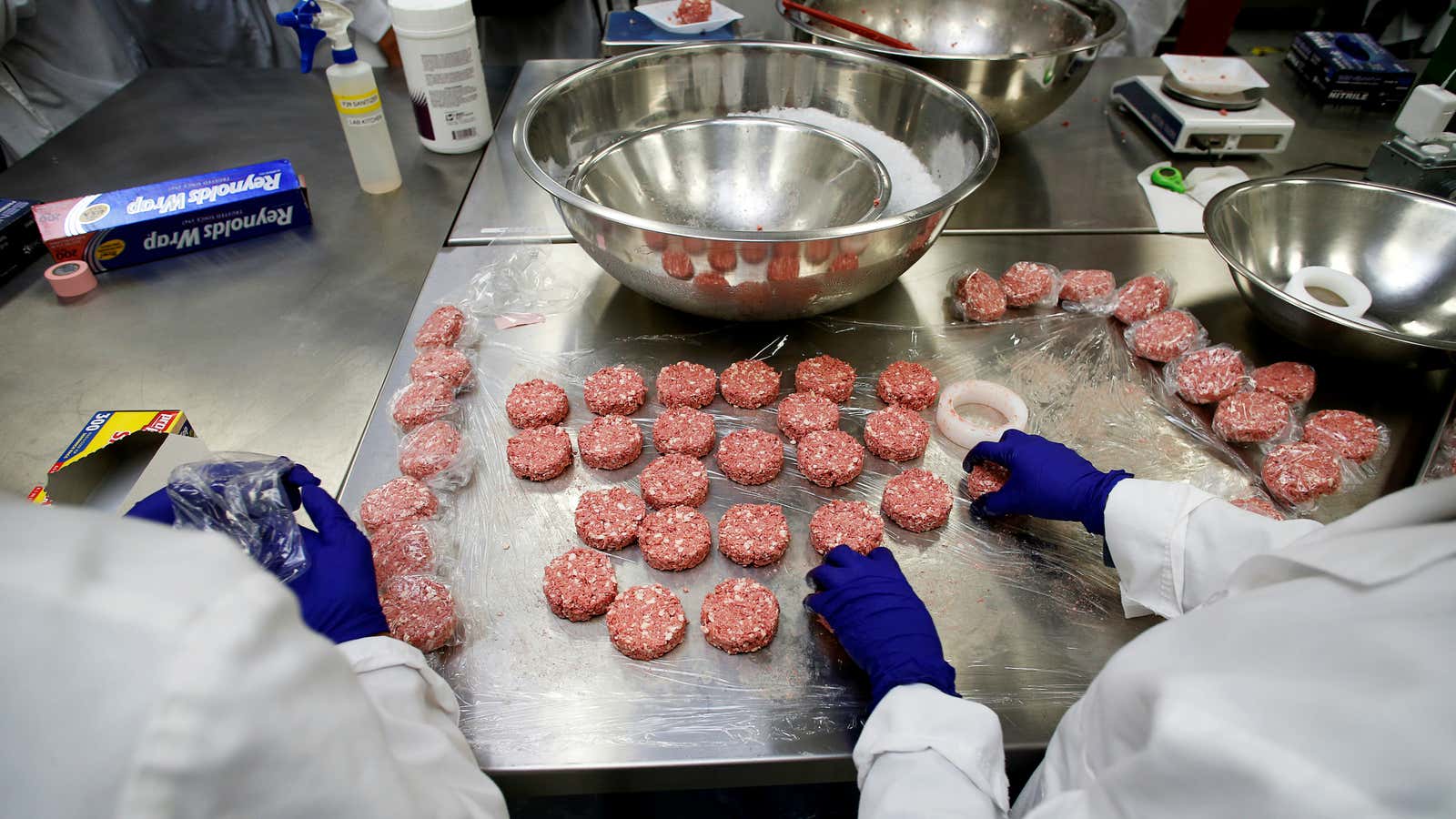There’s a fight going on over burgers—only the cows are watching from the sidelines.
As Americans increasingly dabble in environmentally-friendly alternatives to meat and dairy, pressure is mounting for new food companies to find ways to convince consumers to give their high-tech products a shot. Nowhere is that battle more pitched than between companies offering meatless burger. So how does one compel a person to buy their first carton of lab-made milk, or first pound of “clean meat” burger?
Two high-profile companies are competing to find an answer to that very challenge: Beyond Meat and Impossible Foods. Both produce meatless burgers, but each has taken a radically different approach to attracting consumer attention. Beyond Meat is committed to getting into supermarkets, where large numbers of shoppers rolling carts by the meat section can take a look at its product, probably for the first time in their lives.
By contrast, Impossible Foods is using social media and celebrity chefs to drive attention to a select few restaurants serving its product—a strategy that generates lots of buzz, but doesn’t necessarily get a huge volume of people trying the product.
Both companies’ burger promise about the same thing: a sustainable alternative to beef that is more environmentally friendly and still tastes good. But the trick to finding the most success will be about walking the thin line that separates a product’s conceptual newness without being so showy that it makes consumers nervous.
The companies are still figuring out how to strike that balance, all the while being watched by other new food companies hoping borrow strategies from the winner’s playbook.
“For both companies to succeed, what they’ve got to do is to simple,” says Phil Lempert, an industry analyst who has studied supermarkets for more than two decades. “They’ve got to get this product into people’s mouths, then they can talk about all the benefits of it.”
The buzzworthy burger
For David Lee, the COO and CFO of Impossible Foods, the success of his company’s burger relies on the buzz it can generate. In Lee’s estimation, the success of the product begins with the premise that a breakthrough innovation in food requires an equally innovative approach to sell it to consumers.
The company is offering a burger made of wheat, coconut oil, and potatoes—but what makes it special is the use of heme, an iron-containing compound found in plants and meat, but is particularly abundant in meat.
“We wanted to make sure we’ve reached and delighted this Millennial consumer in a way they wanted to be reached,” Lee says. “That meant putting it in the hands of people who are deeply admired.”
In June, Impossible Foods teamed up with celebrity restaurateur David Chang to offer its meatless burger at one of Chang’s New York City restaurants, Momofuku Nishi. Word of the offering immediately splashed across the news, including outlets as diverse as Vogue and the New York Post. All of those publications offered the same thing: a glimpse at the non-meat burger that literally bleeds.
Four months later, Impossible Foods partnered with chefs Traci Des Jardins and Chris Cosentino, the owners of upscale San Francisco restaurants Jardiniere and Cockscomb, respectively. Again, the burger was featured throughout Bay Area media again and again.
“I think what you’re seeing is this movement that we’re trying to create,” Lee says, emphasizing that the company is focusing on getting into the food service industry at the moment.
That can be an aggravating thing to watch for the people at Beyond Meat, which has less control over its targeted buzz by virtue of the strategy it has chosen for getting in front of consumers. Even still, the Beyond Meat approach has upsides that its competitor cannot enjoy.
Charming grocery shoppers
As Beyond Meat CEO Ethan Brown puts it, the innovative story behind his pea protein-based burger is just as paramount as a person’s ability to pick it up in a grocery store, examine the packaging, and be curious enough to stick it in their grocery cart. That means striking shoppers as trustworthy and familiar.
“Innovation is great for my iPhone, but I don’t want to put it in my mouth,” says Brown, adding that consumers should never be turned off by the newness of his product, which can be found in more than 11,000 US supermarkets.
The company in October announced that Tyson Foods, one of the biggest meatpackers in the US, invested an undisclosed amount of money for a 5% stake in the company (paywall). It a signal that Big Meat has realized plant-based alternatives are worth keeping an eye on. It also opened a door of opportunity for Beyond Meat, as partnering with Tyson could help win its products attention and better supermarket placement.
The Beyond Meat people have expressed frustration that Impossible Foods can get intense media coverage when it lands in a new market, but they also say they understand payoff of that kind of coverage is ephemeral.
In Lempert’s estimation, Beyond Meat is well-positioned because it already has good brand standing and it’s increasingly available in retail outlets throughout the US. Still, both companies would have a lot to gain by turning to the other’s playbook, he says.
“I think that for Beyond Meat, they need some buzz with chefs, because for today’s environment that’s important to consumers, especially for millennials,” Lempert says. “And I think for Impossible Foods, they need the supermarket because that’s where they are going to need to sell, and that’s how you make money.”
He also cautioned against ruling out any new entrants from entering into the competitive mix, warning the ability for Silicon Valley to pull a surprise is very real—and one of the reasons the tech ecosystem is personally intriguing to watch.
